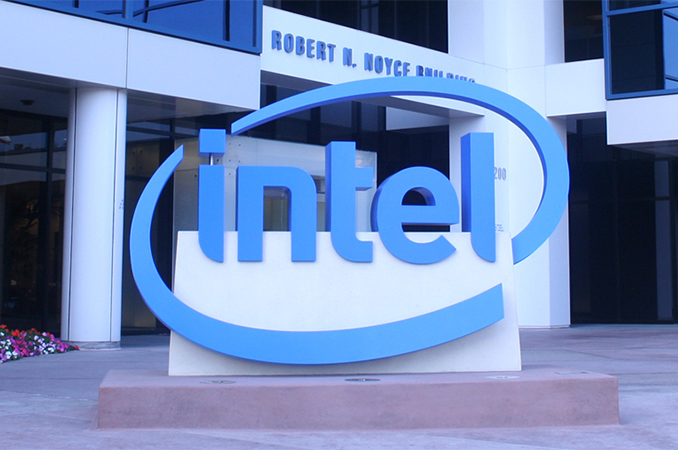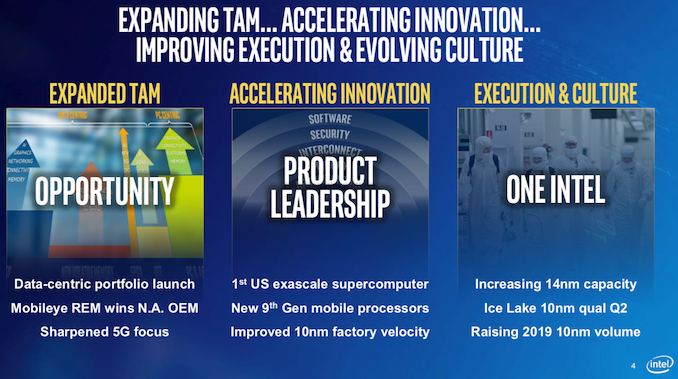Intel Starts Qualification of Ice Lake CPUs, Raises 10nm Volume Expectation for 2019
by Anton Shilov on April 25, 2019 5:14 PM EST
During its Q1 earnings call, Intel provided an update regarding its 10 nm process technology as well as the ramp up of its Ice Lake-U processor for notebooks, which is the company’s first 10 nm design that will be mass produced and broadly available. Qualification for the new processors has already started, so systems based on Ice Lake-U will be available by the holidays, as promised. Furthermore, Intel believes that it will be able to ship more 10 nm parts than it originally anticipated.
Ice Lake-U in 2019
Intel started production of its Ice Lake-U processors in Q1, but Intel has been building up a stockpile of them first before they are sent to PC makers for qualification. Once the CPUs are qualified — something that Intel expects to happen in Q2 — the manufacturer can start sales/shipments of these CPUs, which will likely happen in Q3. Considering the lead-time required to get built systems on to store shelves, Ice Lake-U-based PCs are on track to hit the market in Q4 (something Intel reaffirmed today).
Intel’s Ice Lake-U is a quad-core processor based on the codenamed Sunny Cove microarchitecture. Among other notable features, on the CPU side of matters Ice Lake-U supports VNNI and Cryptographic ISA instructions, as well as Intel's long, long awaited support for LPDDR4X memory. Meanwhile on the GPU side of matters, this is the first chip to integrate Intel’s Gen11 iGPU, which with up to 64 execution units, promises a big step up in performance. The CPU will be paired with a chipset natively supporting Thunderbolt 3, 802.11ax Wi-Fi, and a number of other innovations. The whole Ice Lake-U package is expected to have a TDP of 15 W, so the product will be able to address thin-and-light and mainstream laptops.
10 nm Volume Goals Increased
It is noteworthy that Intel now expects to ship more processors made using its 10 nm process technology than originally anticipated this year as it can produce more these CPUs.
“On the [10 nm] process technology front, our teams executed well in Q1 and our velocity is increasing,” said Bob Swan, CEO of Intel. “We remain on track to have volume client systems on shelves for the holiday selling season. And over the past four months, the organization drove a nearly 2X improvement in the rate at which 10nm products move through our factories.”
Ice-Lake-SP Xeons in 2020
As for 10 nm ramp in general, Intel is only talking about producing its relatively small Ice Lake-U processors in volumes this year, which is the company’s typical way of ramping up a new node. When it comes to their larger Ice Lake-SP server parts, Intel expects to launch those 10 nm Xeon products in 2020. The company says that its Ice Lake-SP CPUs will be available in less than 12 months after its Ice Lake-U products hit the market. In fact, Intel has even advised investors to expect 10 nm Xeons to arrive “rather sooner than later” in 2020, which would imply something earlier than Q4'2020.
Related Reading:
- CES 2019 Quick Bytes: Consumer 10nm is Coming with Intel’s Ice Lake
- Intel 10nm Production Update: Systems on Shelves For Holiday 2019
- Intel Delays Mass Production of 10nm CPUs to 2019
- Intel’s Xeon Scalable Roadmap Leaks: Cooper Lake-SP, Ice Lake-SP Due in 2020
- First 10nm Cannon Lake Laptop Spotted Online: Lenovo Ideapad 330 for $449
- Intel Discloses Plans to Spend $5 Billion on Fab 28 Expansion in Israel
- Intel's 10nm Briefly Appears: Dual Core Cannon Lake in Official Documents
- Intel Mentions 10nm, Briefly
- Intel Displays 10nm Wafer, Commits to 10nm ‘Falcon Mesa’ FPGAs
- Intel: EUV-Enabled 7nm Process Tech is on Track
Source: Intel











70 Comments
View All Comments
bug77 - Friday, April 26, 2019 - link
I believe it's AMD's job to get the OEM interested and involved. And they're way better at this then they were back in AthlonXP/64 days.Irata - Friday, April 26, 2019 - link
Yes, but if the OEM are made offers that they cannot refuse ? I mean, it would be a shame if an OEM were to be particularly affected by Intel's CPU shortage while working on new Ryzen based systems. These things can happen...bug77 - Saturday, April 27, 2019 - link
As I said, that game is between AMD and OEMs ;)HStewart - Thursday, May 2, 2019 - link
Do you really think OEM's like Dell and HP ( for example ) don't know what coming from Intel? They know and that is why they don't care about Ryzen systems - maybe some on desktop side and maybe some on mobile side.But think of has OEM owner, why build a product for fans that would rather build there own system then purchase from OEM. Where the main purpose of fans is not for customer for fans to buy there systems but instead fans hoping to get OEM to make systems for other people so they hurt Intel. OEMs are smart and will not fall into this trap.
HStewart - Thursday, May 2, 2019 - link
Field on extreme minority of market is not a big deal.dew111 - Thursday, April 25, 2019 - link
"As for 10 nm ramp in general, Intel is only talking about producing its relatively small Ice Lake-U processors in volumes this year, which is the company’s typical way of ramping up a new node."No it's not. On 14nm and 22nm releases, they released a full range of desktop parts first. This strategy was typical as of 65nm and 45nm, but that was over 10 years ago.
dew111 - Thursday, April 25, 2019 - link
Nevermind, I am wrong.psychobriggsy - Friday, April 26, 2019 - link
It was usually only 6 months from U/Y series chip (basically a chip to let Intel crow that it has reached Xnm) to full desktop chips however.Desktop 10nm here is not happening.
10nm is for mobile and Xeon - neither need ~5GHz capable CPUs. That indicates where the problem is.
aryonoco - Thursday, April 25, 2019 - link
I distinctly remember that the first 14nm products were Broadwell Y and Broadwell U in late 2014. Desktop parts didn't become available didn't become available until mid 2015, by which point they were nearly deprecated and superseded by Haswell.Klimax - Friday, April 26, 2019 - link
You mean by Skylake. Broadwell was after Haswell.